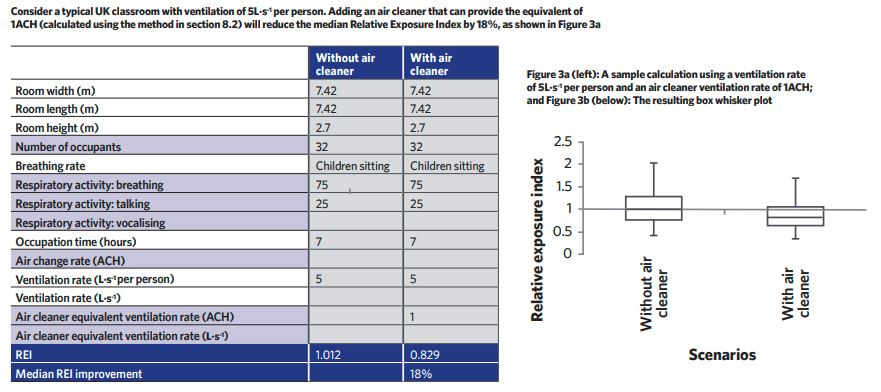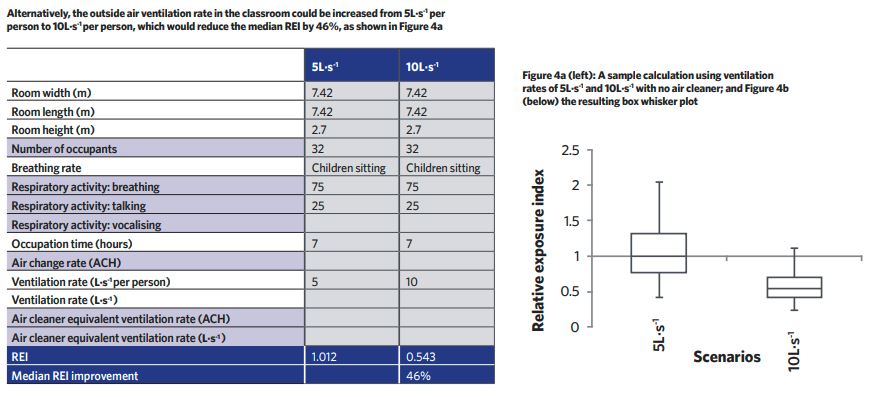
In July, CIBSE published the new Covid-19: Air cleaning technologies guide as part of its series Emerging from lockdown. The world of air cleaning devices is extremely complex. This guide aims to help engineers and building managers to assess whether an air cleaning device might be beneficial, and whether the device they are considering is fit for purpose and, above all, safe.

The guide gives a brief introduction to removal mechanisms for SARS-CoV-2, a summary of the existing guidance related to the different technologies employed for air cleaning, and several tools and worked examples to help specifiers determine the potential impact of an air cleaner introduced into a space.
Chief among these is the Relative Exposure Index Calculator. This article gives a brief introduction to the topics covered in the guide.
Government statutory guidance on Covid-19 safety should be followed at all times. Air cleaning devices should not be used as a substitute for adequate ventilation.
Devices that clean the air have existed for many years. They range from the well known, such as mechanical filtration, to more novel and less studied methods, which employ a variety of catalysts, ionisers, electrostatic or other techniques to physically or chemically alter particles passing through them.
Historically, many of these devices were marketed for the removal of chemical pollutants, such as volatile organic compounds (VOCs) or particulates, with less of a focus on pathogens. With the emergence of Covid-19, attention has turned to how these devices can be applied to reduce infection risk, particularly from airborne particles carrying SARS-CoV-2.
As SARS-CoV-2 is a relatively new virus, there is not a large body of research on the specific effectiveness of any technology for application against it. However, organisations including the World Health Organization (WHO) and the Scientific Advisory Group for Emergencies (SAGE) have reviewed the literature that does exist and made recommendations based on the best available evidence. The new guide summarises these recommendations.

There is also a lack of guidance on the specification and selection of air cleaning devices, especially in commercial settings such as offices. The suitability of air cleaning devices is determined by several factors, including the existing provision of outside air, the level of occupancy, the location of the device, its removal efficacy, and how much air passes through the device over time. The guide highlights the calculations a specifier should undertake to assess whether an air cleaner is suitable for a space.
On top of these physical factors, the internal chemical environment is extremely complex. Many of the novel technologies rely on chemical reactions as a cleaning mechanism, with some capable of generating pollutants that are harmful in themselves, including ozone and other VOCs.
Having a full understanding of the risks, however small, and the long-term maintenance requirements of any technology placed in a building is key to ensuring long-term occupant safety. Flowcharts containing questions suppliers should be able to answer are included, to help non-specialists navigate this complexity.
The guide highlights the calculations a specifier should undertake to assess whether an air cleaner is suitable
It is worth noting that the guide does not address the use of ultra-violet germicidal irradiation (UVGI). The authors acknowledge that UVGI can be extremely effective against pathogens and is well proven, particularly in healthcare settings. The safe application of UV technologies, however, is an equally complex and specialist science, and it was decided that it would be best served by a guide of its own. References are provided to existing guidance on UVGI.
The guide was created following a thorough review of the existing science and guidance on air cleaners, drawing on expertise from the world of air quality, chemistry, biology, ventilation, and mechanical engineering. While it doesn’t examine the detail of specific technologies, the authors hope it is referenced thoroughly enough to serve as an entry point to allow those seeking deeper knowledge to find it.
Safety first
The Covid-19 pandemic created an urgent need for safer indoor spaces. Despite this, the drive towards healthy air must be undertaken in a way that not only deals effectively with airborne viruses, but also does not lead to unintended health impacts.
The market for air cleaning devices includes an extremely wide range of products, technologies and prices, with consumer devices available from less than £100. As an industry, it is lightly regulated, particularly in terms of the chemistry of the devices, where thorough testing is expensive. As a result of this, it is difficult for the non-specialist to determine what health impacts any device could have.
In general, the recommendation is to err on the side of caution. SAGE Environmental Engineering Group and others, including ASHRAE and the Environmental Protection Agency, caution against using devices that produce ozone, ions or other chemicals without independent evidence for their safety and efficacy, as the by-products created by these technologies may act as respiratory irritants.

The guide includes a flowchart of questions for the specifier to ask potential suppliers. While trying not to rigidly favour any particular technology, more established technologies such as mechanical filtration, which are relatively inert from a chemical perspective, are simpler to specify.
From a ventilation perspective, the guide describes the methods that specifiers can use to translate a manufacturer’s claims into a robust assessment of performance:
Equivalent ventilation rate (eqACH)
In simple terms, this metric is used to measure the amount of air treated by a device in terms of the equivalent air changes per hour of clean air. Ventilation should always be the first choice, but in spaces where this is not possible, this metric can be used to assess the ability of a device to clean the air.
The clean air delivery rate (CADR)
The CADR is a commonly used metric that can be useful for comparing devices and for comparing the impact of dilution through ventilation. In the absence of this test-derived data, the guide provides a method to estimate the CADR from a product data sheet.
The relative exposure index (REI)
Developed by Benjamin Jones et al,2 the REI is used to highlight types of indoor space, respiratory activity, ventilation provision and other factors that increase likelihood of far-field exposure to SARS-CoV-2.
The guide is accompanied by a simple yet powerful spreadsheet tool, which enables specifiers to assess the impact of different interventions on a space, including ventilation, occupancy rates and the introduction of an air cleaning device. An example is shown in Figures 3a and 4a.


An air cleaner is for life, not just for Covid
Responsibility for maintenance and operation of any devices should be identified at the outset. The likely users of the devices should also be educated on the correct operation of these. Studies have shown that the effectiveness of devices in practice is linked to issues including thermal comfort and noise, so ensuring building occupiers know what they are for – and how they work – is key.
Devices based on mechanical filtration should follow standard industry practice on filter replacement and safe disposal. The long-term performance of novel air cleaning devices is not well studied. Again, it is recommended that specifiers err on the side of caution and ask for clear, concise information on how to maintain any device, including replacement intervals of any operating parts.
Healthy people and a healthy planet
The guide has largely taken a relatively short-term look at the application of air cleaners. This was on the basis that the current pandemic will, hopefully, be brought under control in a reasonable period and that their use will be temporary.
While it is not covered explicitly, the long-term energy implications of any air cleaning device should still be at the forefront of everyone’s minds. All air cleaning devices either use energy directly or increase the consumption of existing systems – for example, increasing the grade of filters in a ventilation system.
As such, the specification of air cleaners, especially those intended to be permanent, must look at the potential longer-term energy consumption of the devices. This should ideally form part of a wider assessment of methods to reduce infection risk and improve air quality, including increasing ventilation where possible.
Any measures should be combined with approaches that mitigate energy consumption, such as demand control.
About the author
Edwin Wealend is the head of research and innovation at Cundall and co-author of the guide alongside Chris Iddon and Dzhordzhio Nadzhiev
References:
- Jones, B et al, 2021. Indoor particle behaviour diagram – accessed 5 May 2021.
- Jones, B et al, 2021. Modelling uncertainty in the relative risk of exposure to the SARS-CoV-2 virus by airborne aerosol transmission in well-mixed indoor air. Building and Environment, Volume 191
Covid-19: Air cleaning technologies is available to download now from the ‘Emerging from lockdown’ section of the CIBSE website
